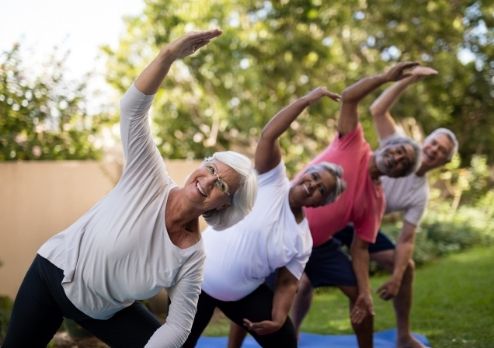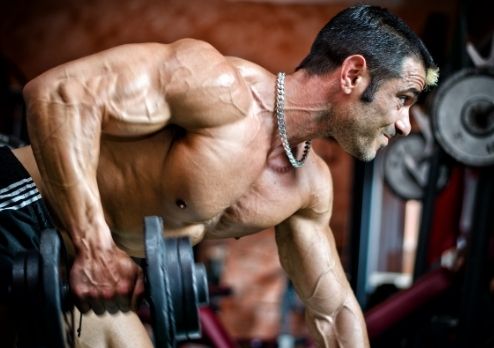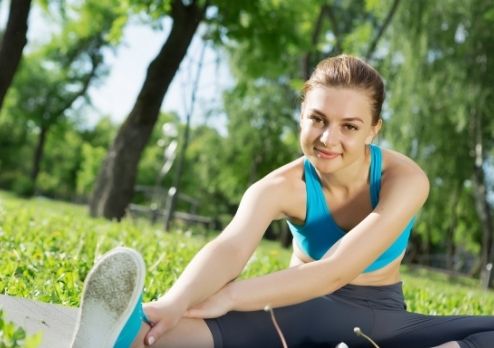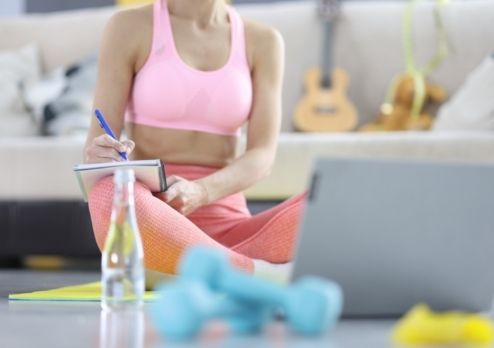
Disclaimer: Consult your doctor before beginning a fitness program, and make sure to take into account restrictions like heart disease, severe obesity, or limiting arthritis.
Exercise is one of the surest ways to help you look and feel younger and help stay healthier. In this age of push-button technology, the average person moves less than at any time in human history. More than half of the population worldwide never exercise at all.
Obesity, heart diseases, diabetes, cancer and many other ailments can be prevented simply by exercising regularly. And this has been established and documented.
Every single bio-marker of ageing that has been studied is altered in the beneficial way by exercise. This includes the basal metabolic rate, which is the amount of energy you expend each day when at rest, your skin thickness and the amount of wrinkles, the body temperature regulation, blood sugar levels or sugar tolerance, hormone levels, sex hormone levels, hearing ability, fat content in the body, cholesterol-HDL ratios, muscle mass, strength of muscles and so on.
So it is very important to stay on the move everyday and do strength training about three times a week thereby changing all the bio-markers that have been stated above – all at once – not one at a time.
Also there is evidence now that exercise and especially strength training including cardio-vascular exercise improves, the delta phase of our sleep. When you have delta deficient sleep, you have amyloid in the brain which is a condition in which proteins build up on the walls of the arteries of the brain, generally called inflammation which increases the risks of stroke caused by bleeding and dementia. Sometimes this leads to increased risk of Alzheimer’s.
Exercise is crucial to reversing your biological age. Of all the approaches to growing younger, exercise produces the quickest returns. After a week of exercise, you will notice definite improvement in your well-being, and after a few weeks, you will not be able to go without it.
But as we all know, exercise can be difficult to make a part of our life. Here are the issues we often face:
- We may go full-speed from Day 1, and burn out before we see results;
- We may lack the motivation to exercise regularly;
- We may be intimidated by our age;
- We may have mobility limitations, stemming from joint pain or illness.
When it comes to your age, know this:
By starting slowly and building gradually, you will be able to keep up your routine and enjoy it. And while fitness centres and gyms can be helpful, you do not need expensive equipment to get a good workout.
How Fit Do You Want to Be?
Understanding your fitness goals is a good place to start your exercise journey.
First, it helps figure out where you currently stand fitness-wise, to give yourself a point of reference. Answer the following questions honestly and without judgment:
- How far and long can you walk? How about run?
- How many sit-ups or crunches could you do in a minute? What about pull-ups?
- How flexible are you? Can you touch your toes from a standing position? How about sitting?
- Do you have difficulty performing everyday physical tasks?
Now that you have a rough idea of how fit you are it is time to create an attainable fitness goal. Your goals should be measurable and tailored to your personal needs.
Perhaps you wish to:
- Perform your daily routine without pain;
- Walk a mile every day;
- Become strong enough to lift your grandchildren;
- Do 30 sit-ups in a minute;
- Exercise for 20 minutes each morning.
The Numerous Benefits of Exercise

Once you begin exercising, you will experience increased flexibility, more energy, greater strength, and decreased body fat. Within six weeks of beginning to train, studies show 100 to 200 percent increase in strength in men aged 60 to 70.
Exercise also has a direct impact on your brain. Studies have shown that exercise can slow or even reverse the decline in brain function.
Remember, that you do not have to strain yourself to get the benefits of exercise. It must be ensured that you have a little bit of sweat or moisture; speeding of the heart rate to levels where it is not uncomfortable; being able to breathe without having the inability to speak.
There are only two or three you must remember:
- Be on the move most of the day;
- It does not matter whether you are 60 years or 80 years of age - you can substantially increase strength of your muscles;
- Exercise actually increases the number of neurons and increases the connection between them. So this helps improve your brain capacity.
So, exercise improves mental capacity, improves the quality of your sleep, improves your moods, and gets rid of depression and many more. There is a general excuse of “too tired to exercise.” When you are too tired, that is the time to exercise because when you finish doing it, you will not feel tired any more.
Use the following feedback mantra to assess yourself:
- Am I experiencing a joyful energetic body?
- Am I experiencing a restful, quiet and alert mind?
You are now ready to bring exercise into your life! The next steps will help you develop strength and endurance.
Invigorate Your Being - Walk!
Walking for 30 minutes, five days a week, can add more than seven years to your life, according to a recent Harvard University study. And without this kind of cardiovascular exercise, studies show you place yourself at risk for heart disease, high blood pressure, and cancer.
Did you know walking is just as effective as running? Best of all, anyone can do it – it is easy and inexpensive.
Here are a few guidelines regarding a brisk walk. Breathe through your nose when you are walking which will increase your endurance. Make sure you do not open your mouth so that you are not short of breath; that you can still comfortably talk if you have to making sure that you have a mild amount of sweating which is a good sign that you are increasing your cardio vascular capacity not to the point of discomfort.
Make sure that you walk at least 20 minutes at a stretch and not break it up to small segments and use whatever opportunity you have to walk. If commuting by Metro, get down one station behind your destination. At Airport do not use the walkways, instead walk. If you have the opportunity to use Elevators, make sure you cover two flights walking. Use every excuse to be on the move. Get used to the feeling of energy when you walk. Anchor that experience in your consciousness and when you are feeling lazy and recall that experience in your mind – the feeling of energy; the feeling of exhilaration; that slightly intoxicated feeling from the endorphins. And if you do this regularly, you will have a healthy addiction to walking.
Keep these health indicators in mind, as well:
- Some mild soreness is common at first, or when you increase your intensity, but you should not experience severe discomfort;
- If at any time you become acutely short of breath or develop chest discomfort, stop your activity and immediately contact your doctor.
If walking becomes a regular part of your routine, you may wish to invest in some good sneakers.
If you enjoyed walking, try other workouts like Biking and swimming. These can become an important - and fun - part of your routine.
Remember, smaller movements also contribute to your overall well-being. In fact, studies show that people who move around live longer than those who sit down all day. So, seek out opportunities every day to be physically active.
How Building Strength Prevents Disease
While walking, biking, and swimming is important for maintaining your heart and lung health, strength training like lifting weights and doing sit-ups is absolutely crucial to your health as you age.
In years past, strength training was left to weight lifters and body builders. Now, we understand that taking good care of our muscles is imperative to avoiding illness. In fact, according to the Centres for Disease Control and Prevention, increasing your muscle strength can slow physiological aging and dramatically improve your quality of life.
Studies have shown that regular strength training reduces the incidence and symptoms of:
- Arthritis: Decreases arthritis pain by almost half;
- Diabetes: Dramatically improves control of blood sugar levels for people with type 2 diabetes;
- Osteoporosis: Increases bone density and reduces risk of bone fractures in women aged 50 to 70;
- Obesity: Increases metabolic rate up to 15 percent, burning many more calories;
- Falls: Reduces the number of falls 40 percent;
- Depression: Provides benefits similar to antidepressant medication and promotes self-esteem.
Strength training is just as important as cardiovascular exercise - it not only builds bones and muscles, and improves body function, but also produces helpful changes in the brain.
Do not forget to Stretch!

Now that you have embarked on the age-reversing journey of cardiovascular and strength training, there is just one final element in the fitness equation: stretching. These gentle, yet essential movements do much more than just prevent muscle soreness.
Done properly, regular stretching can:
- increase or maintain your range of motion;
- reduce your risk of injury;
- help your posture;
- improve your circulation;
- Decrease your risk of lower back pain.
And let us not forget, stretching also feels good!
Stretching Guidelines
Always remember: Stretching should be a gentle activity, and if you feel pain, you have stretched too far. If you have any injuries or impairments, talk to your doctor about which stretches are right for you.
Dynamic stretches: (meaning you move while you stretch) help increase flexibility for whatever exercise you plan to perform. For example, if you are about to go on a vigorous walk, exercise physiologists advise doing a short set of slow, controlled, exaggerated motions that mimic walking. This slowly brings up your heart rate and loosens your muscles.
Static stretches: (meaning stretch and hold) are the classic stretches most people are familiar with and should be done when your muscles are warmed up; Post-workout is a good rule of thumb.
According to research published in the March 19, 2020, issue of “Redox Biology,” exercising regularly may also help prevent acute respiratory distress syndrome (ARDS), which is very common in COVID-19.
Aside from eating a varied, whole-food (ideally organic) diet and implementing time-restricted eating, exercise is a foundational health strategy that will strengthen your immune function. Another way in which physical activity can help protect against COVID-19 is by combating immunosenescence, the decline in immune system function that typically occurs with aging. Immunosenescence is believed to be one reason why the elderly are at such increased risk for viral infections in general and COVID-19 specifically.
What is more, exercising can get you outside in nature, which conveys mental health benefits as well as physical health benefits, as your body synthesizes vitamin D from direct exposure to sunlight, which contributes enormously to immune function. The benefits of vitamin D for COVID-19 are mentioned below. A separate chapter has been devoted for vitamin D.
There are many types of exercise, but one of the best is a type of resistance training called blood flow restriction (BFR) training, which involves slightly restricting arterial flow and obstructing the venous return from the muscle back to the heart. This is done by applying bands to your arms or legs while exercising with very low weights at high repetition.
It is a nearly perfect strategy for anyone over 50 or 60 to gain muscle mass with minimal risk of injury. You do not even need weights to practice this technique. BFR is considered as one of the most powerful strategies to keep you healthy in the long term.
Check in with Your Body and Emotions
Now that you have tackled both cardiovascular exercise and strength training, you are closer to realizing your Biostat (your perfect age within 15 years of your current age), and feeling and looking as youthful as you are in your heart.
Take this time to check in with your mind and body. Are your legs tired? Is your heart rate steady? Does your spirit feel uplifted? Read the responses below and select as many as you would like.
Select all that apply: Happy, Excited, Energized, Calm, Tired, Sad, Frustrated, Embarrassed, Confused, Doubtful, Proud, Discouraged, Encouraged
When you have finished taking the poll, move on. You shall be helped to create an age - reversing exercise routine that fits your life.
Create Your Routine
Now you need to make room for fitness in your life. Establishing a regular time for your routine will help you stick to your plan.
When deciding on a time, keep the following in mind:
- Every day, you should try to do 20-30 minutes of aerobic activity, like walking, biking, hiking, swimming, or dancing;
- Follow this with 5 to 15 minutes of basic stretching;
- Two or three times a week, add 20-30 minutes of strength training exercises.
Remember to start small, increasing the intensity and duration of your exercise. And if you only do a little each day, that is okay. Any exercise you get is better than none. Maintaining a routine and building gradually are crucial for success.
How to Stay Motivated

If keeping yourself motivated is a problem, try some of these ideas that should work well:
- Create your own fitness milestones. ("By next week, I will do 6 push-ups in a row!");
- Find an exercise buddy who keeps you honest.
Exercise buddies, whether they are friends or family members, make you accountable, inspire you on low-energy days, and can help you identify your weaknesses or training difficulties.
However you choose to stay motivated, remember to celebrate your improvements, and how they make you feel, especially in terms of mood and energy level.
Monitor Your Progress
Measuring your performance can be helpful as you exercise your way toward a younger biological age. But, while established physical standards are helpful, you can best gauge your progress by listening to your body.
The best biosensors are already in our body called the feedback loops. When you are healthy you feel energetic, joyful, enthusiastic and inspired. You have good sleep and healthy appetite. You have healthy sexual energy. When you are not healthy then you lose your appetite and your breath becomes stale, you feel lethargic, your emotions get toxic and your sleep gets disturbed. This is commonsense but we do not pay attention to this.
Having said that, we are now living in a very interesting age where there are all kinds of biomarkers from some of the reputed companies worldwide that help you to get feedback and change your behaviour especially if you use these with the people in your community, your social circle or with your family.
Biomarkers are indicators of biological events. They are either present, or not; they may increase or decrease; or simply change form. They relate to normal biological states, the presence of disease (or the risk of it), or in response to intrusions into the body, including medical treatment or injury. Above all else, biomarkers provide information - about a person’s current health or to give clues related to future health.
The role of smart phones and AI-driven data is now top on the priority. They are the natural home base for collecting, analyzing, and distributing the information gained from cameras, microphones, and other sensors embedded in digital technology.
I personally use my Android Smartphone embedded App called “Samsung Health.” It gives me feedback about my Walking, Exercise, Sleep, Weight and Water Intake.
Each of these gadgets does certain things that are common. It tells you how many steps you took and how many calories you burn. Some of them tell you the amount of sleep you had last night and how many times you woke up or how many times you went into deep sleep. It monitors your sweat activity, skin temperature, heart rate and many other parameters.
Total Fitness
Once you begin to stick with your exercise program, it will not take long for you to feel stronger, more flexible - younger.
In addition to improving your sense of well-being, you will lose weight, sleep better, and experience fewer digestive problems. Most importantly, you will begin to look and feel your Biostat.
No one can take this step toward better health but you. Start today and you will quickly see yourself growing younger.
Exercise can, and should, become a healthy addiction. Aim to do something active every day, seven days a week. Remember, something is always better than nothing. And the more you exercise the more joy you will experience.